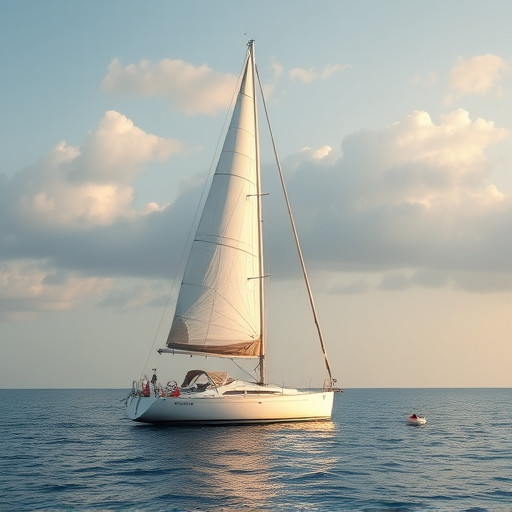Sailing, an Ancient Art: Sailing harnesses wind power through expertly manipulating sails and boat positioning. It requires understanding meteorology and boat handling for navigation and safety. Sailboat designs vary from racing yachts to cruising catamarans, each optimized for specific sailing conditions and preferences. Key components include the hull (for buoyancy), rigging (for sail support), sails (for wind capture), and the rudder (for steering). This diversity ensures there's a sailboat suited for every need, from agile dinghies to massive yachts.
Introduction: Unfurling Sails, Exploring the Open Sea
Sailing is an art that combines ancient traditions with intricate engineering, allowing humans to harness wind power and glide across oceans. This article delves into the captivating world of sailboats, exploring their operation, diverse designs, and the thrill of navigating the open sea. From understanding the fundamentals of sailboat dynamics to discovering various types and their unique characteristics, we will uncover the secrets of this timeless maritime endeavor. Whether it’s a day trip or an epic ocean crossing, get ready to set sail and discover the magic of wind-powered vessels.
- The Fundamentals of Sailboat Operation
- – Definition and basic principles of sailing
- – Components of a sailboat: Hull, rigging, sails, and steering
- Types of Sailboats: A Variety of Designs
The Fundamentals of Sailboat Operation

The fundamentals of sailboat operation revolve around harnessing the power of wind to propel the vessel forward. This is achieved through the strategic use of sails, which capture and convert kinetic energy from the atmosphere into movement. At its core, sailing involves understanding how different sail configurations interact with the wind, allowing sailors to navigate in various directions depending on the breeze’s angle.
Sailboats are typically steered using a tiller or wheel connected to a rudder, enabling precise control of their course. The art of sailing lies in balancing the vessel’s motion by adjusting sails and rudders according to wind conditions. Skilled sailors anticipate changes in wind patterns, skillfully manipulating sails to maintain speed and direction, ensuring a smooth and efficient journey on the water.
– Definition and basic principles of sailing

Sailing is an ancient maritime art that harnesses the power of wind to propel boats across bodies of water. At its core, sailing involves utilizing large fabric panels called sails to capture the energy from the wind and convert it into forward motion. This basic principle relies on three fundamental forces: lift, drag, and leverage. The sail catches the wind, creating lift which pushes against the boat, while drag acts in the opposite direction of motion. Leverage is achieved through the hull and mast design, allowing sailors to control the angle of the sails relative to the wind, thereby maximizing efficiency and speed.
The act of sailing requires a deep understanding of both maritime skills and meteorology. Sailors must anticipate wind patterns, adjust sail configurations accordingly, and navigate safely around potential hazards. Different sailboat designs cater to various purposes, from racing yachts to cruising catamarans, each optimized for specific sailing conditions and experiences. This diversity in sailboat types reflects the versatility of this age-old practice, which continues to captivate adventurers seeking both challenge and tranquility on the open sea.
– Components of a sailboat: Hull, rigging, sails, and steering

A sailboat is a marvel of marine engineering, composed of several key components that work in harmony to harness the power of wind. At its core lies the hull, which provides buoyancy and stability, typically constructed from materials like fiberglass, wood, or composite materials. The rigging—a network of ropes, cables, and stays—is responsible for supporting the sails and allowing them to be adjusted for optimal wind capture.
The sails themselves are a delicate balance of design and material science. They catch the wind, converting its kinetic energy into forward motion through a combination of lift and drag. Depending on their shape and orientation, different sail types serve various purposes: main sails for primary propulsion, jibs and spinnakers for enhanced speed and maneuverability in different wind conditions. Steering is facilitated by a rudder, connected to the hull via a steering oar or tiller, allowing sailors to navigate the boat with precision.
Types of Sailboats: A Variety of Designs

Sailboats come in a wide variety of designs, each tailored to specific sailing needs and preferences. From small dinghies perfect for leisurely days on the water to massive yachts capable of long-distance cruising, there’s a sailboat out there for every purpose. One of the most common types is the keelboat, known for its stability and seaworthiness, with a fixed keel that provides excellent balance while reducing drift. On the other end of the spectrum, dinghies are small, lightweight boats often used for racing or recreational sailing, offering agility and ease of handling.
Another popular category is the sloop, characterized by its single mast and jib sail configuration, which makes it versatile and easy to manuver. Catamarans, with their twin hulls, offer increased stability and speed, making them ideal for both racing and cruising. For those seeking a unique experience, traditional designs like the gaff rig or mastless sailboats provide a touch of history and a different way of interacting with the wind. Each type offers distinct advantages, catering to various sailing styles and preferences.
In conclusion, sailboats operate through a harmonious blend of wind power and human skill, utilizing various components and designs to navigate the seas. From understanding the fundamentals to exploring diverse sailboat types, we’ve delved into the world of sailing, highlighting how these vessels can traverse vast distances with grace and efficiency. Whether for leisure or adventure, sailing continues to captivate enthusiasts worldwide, offering a unique connection with nature’s constant and unpredictable force—the wind.
